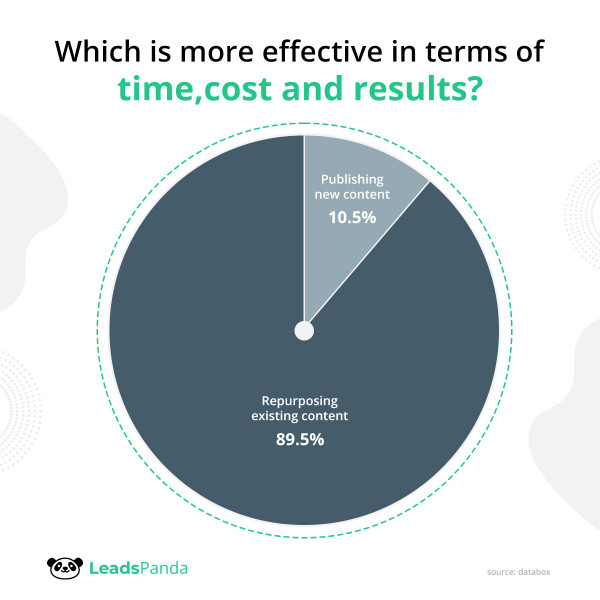5 Best Practices for Repurposing Content
Have you considered repurposing your content? It can be a great, low-effort way to increase your search relevance while building audience engagement.
Your blog archives are probably a treasure trove of useful posts that you could reuse to reach a wider audience. Repurposing content helps you save time and helps ensure you’re able to produce and publish content consistently, which is crucial for successful content marketing.

Take note, however, that reusing content isn’t simply about cloning a post or copying and pasting old material onto new platforms. It’s about knowing what content deserves to be repurposed, knowing how to tweak content to make it more relevant, and editing your core message while staying true to your vision. This post will help you dig deeper into how you can best approach repurposing content for your business.
1. Make Sure the Content You’re Repurposing Is Evergreen
“Evergreen” refers to content that is continuously relevant and stays fresh for readers regardless of the date. One way to keep evergreen content up to date is to replace some key terms or add missing keywords so it shows up for readers based on the latest, evolving search terms related to the topic in question.
For blog posts, a few tweaks here and there to increase searchability and update concepts can boost the traffic that a particular evergreen post can drive to your site. Another option is reformatting a blog post and converting it into a video, infographic, or social card. A survey conducted by Databox found that, according to marketers, the top three best ways to repurpose a blog post are creating a video out of it, creating a downloadable PDF, and designing an infographic.

In short, converting existing content into something easier to share and more engaging is the goal. Add a bit more research and effort, and you’ll get great ROI.
2. Make Data-Driven Decisions On What to Repurpose
The great thing about content marketing is that you can easily collect data to help you understand what content did well, what material didn’t, how audiences interacted with your post, and what you can do to improve the content further.
If you’re taking the time to repurpose content, it makes sense to go the extra mile and study your analytics to understand what really works and then use that to guide your repurposing strategy.
3. Step Out of The Box When You Repurpose Your Content
In addition to tweaking older successful posts and using them to make infographics or how-to videos, there are other repurposing strategies that may be worth exploring.
For example, syndicating content—which is the practice of republishing your material on other sites as a guest blogger or as a contributor—is a great way to boost your exposure. It can be a cost-effective way to expand your audience, increase backlinks, and introduce your brand to a wider audience.
If you have more time and resources, converting articles into a podcast—either as a back-and-forth discussion between hosts or an entertaining audio recording—is a great way to tap into the 121 million Americans who tune in to podcasts today.
Online courses are also a good idea. By repurposing your blog posts into smaller, shorter, how-to educational content, you have an opportunity to build your authority and credibility on a specific subject matter.
Remember, repurposed content maintains consistent messaging but you are reaching out to different audience personas.
4. Repurpose Content Based on Your Target Platforms
This leads us to the next point: always consider your chosen medium’s requirements and demographics. Familiarize yourself with the different media and platforms at your disposal and learn more about what makes each channel unique. Tailor your content to make it more appropriate and relevant to the audience you’re trying to reach—where they are spending their time.
Work within the requirements and personality of each platform. For example, if you originally created a blog post, you can divide it into shorter pieces and create graphic social cards to repost on Instagram or Twitter. You can transform it into short-form video content as well and publish it as an Instagram Reel or TikTok video. You can find relevant questions to answer on Quora and adjust your blog post’s tone to make it more conversational to better prompt engagement. Or you can pull short snippets and quotes and repost them on Twitter.
5. The Simplest Way to Repurpose Content: Create Engaging Images
The best and simplest way to refresh old content? Just add engaging images to your blog posts.
Images in blog posts can help make a post more engaging, boosting interaction with readers, and sending a signal to search engine algorithms that your content is worth ranking.
If you have the resources, you can create images to engage and educate your readers and complement your content. Then use the same images on social media with a call to action that leads them back to read the full post on your website.
Remember, the average human can process visual content 60,000 times faster than text. You can maximize this opportunity by creating visual content that supports your messaging and makes your post more interesting, engaging, and memorable.
Repurposing Content for Content Marketing Success
Consider your own media consumption. On any given day, don’t you scroll through memes? Save infographics? Get sucked into watching reel after reel or Tiktok after Tiktok? Read articles, watch YouTube? Play games? Listen to podcasts?
In short, readers like to consume media in different ways. As such, there are many opportunities for content marketers to repurpose their content to boost online visibility and audience engagement. Start with these best practices if you plan to repurpose your content or, if you want to learn how LeadsPanda can help level up your content production, reach out to us. Book a consultation today.
For any questions, leave a comment below or check out our LinkedIn or Twitter.
Share This Story
Get the latest growth ideas, strategies, and best practices delivered to your inbox.
Quick read that helps 7000+ subscribers.








